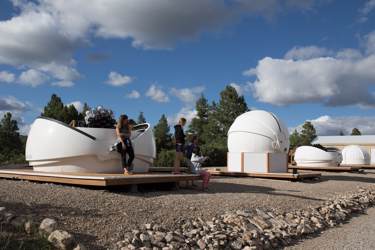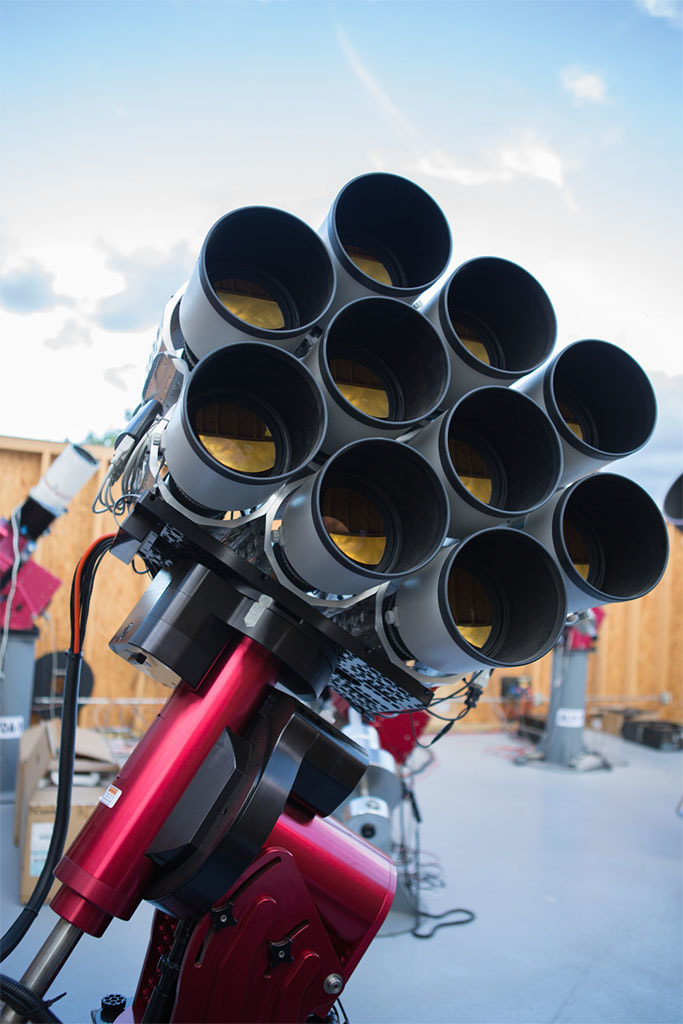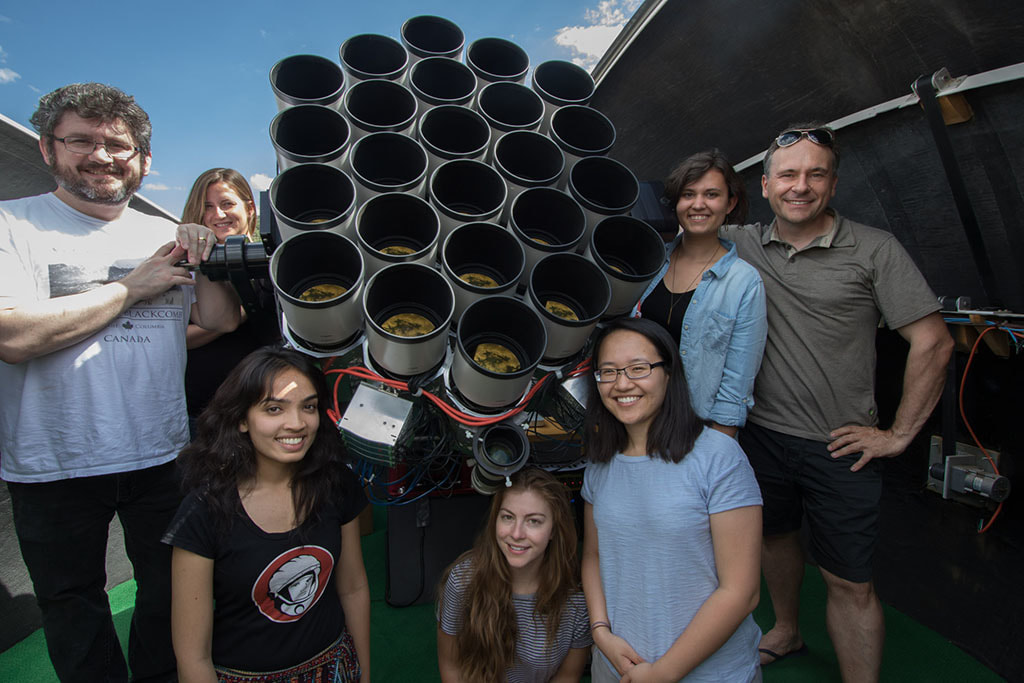Dragonfly Telephoto Array Discovers Ultra Diffuse Galaxies, Challenges Understanding of Dark Matter

By Abby Proch, former editor

Large-scale telescope projects such as James Webb Space Telescope that have enraptured even the most peripheral space enthusiasts often take decades of dedication and billions of public and private funds to help realize their goals. That bothers astronomer Dr. Roberto "Bob" Abraham, who teamed up with fellow astronomer Dr. Pieter van Dokkum to embark on a more intimate project with near-immediate results, one that unexpectedly changed the way astronomers think about dark matter.
The Dragonfly Telescope Array, developed in 2013, was born out of equal parts frustration and wonderment. Nearly a decade into its lifespan, the revolutionary ground-based telescope is getting an upgrade, as researchers continue to explore ultra-low surface brightness structures and attempt to better understand the nature of dark matter in the near universe.
The Nymph Stage
Abraham didn’t know his team of Yale and University of Toronto researchers would so readily stumble upon an ultra diffuse galaxy (UDG) almost entirely devoid of dark matter. But that was always a possibility. Afterall, the team grew out a desire to do more, quicker.
A bit of backstory: Abraham has committed more than a decade of his career helping the James Webb Space Telescope approach deployment and (soon) make discoveries regarding our universe’s origin. While he loves the project and its practically endless possibilities, he can’t help but lament its pitfalls.
“It just started bugging me that everything takes forever. And the reason it bugged me more than anything is that astronomy is really a unique science in that it is completely possible for people to make mind-shattering, huge discoveries without needing to invest in these gigantic telescope projects,” he explained recently.
He wasn’t alone in his sentiment. In 2012, Abraham, professor and chair of the David A. Dunlap Department of Astronomy and Astrophysics at the University of Toronto, and van Dokkum, of Yale University, went out for a few beers and a “complaining session” ensued, said Abraham. Turns out they had the exact same itch: to pursue something more immediately meaningful as the world’s latest and greatest space telescope slogged toward completion.
Dr. Roberto "Bob" Abraham, Dragonfly
As it happens, van Dokkum is an amateur photographer (with a special interest in dragonflies) who heard about Canon’s innovative nano-fabricated lens coating that is excellent at suppressing scattered light. Interested in capturing ultra-low surface brightness astronomy at visible wavelengths, the two split the cost of the roughly $10,000 Canon 400mm f/2.8 lens, which also boasts a single monolithic wide-field detector covering six square degrees. The two then met somewhere “equally inconvenient” between Toronto and New Haven, Connecticut, in star-lit Quebec province, where they tested their idea.
There, a fledgling Dragonfly Telescope Array was born, with the simple goal of better understanding dark matter by exploring low surface brightness structures in the near universe. Soon, the one-lens prototype (backed by a commercial CCD camera) evolved into a three-lens setup, then eight lenses, then 24, then 48.
“We're effectively, if we have 48 lenses, a one-meter aperture telescope. But the focal length is only 400mm. So that means it's f/0.4, which is faster than the thermodynamic limit. You cannot make a lens that is one meter in diameter that can come to a focus at 400mm; it just violates the second law of thermodynamics,” said Abraham.
For each lens, the individual exposure time is 10 minutes, and for most occasions, three sets of 10-minutes exposures are ideal. Multiply that by the number of lenses used, and one session could produce upwards of 30 or 40 hours of exposure data, said Abraham. A telescope with a single lens might have to image the sky for 100 hours in perfect conditions to compete.

Unexpected Discoveries
The Dragonfly team set out to study very large, very low surface brightness structures. That includes sweeping phenomena, like faint field dwarfs, galaxy haloes, and light echos. But in 2014, Dragonfly discovered a new class of objects, ultra diffuse galaxies (UDGs). These UGDs were originally found in the Coma cluster but are now being found throughout the universe. UDGs are the size of the Milky Way but contain between far fewer stars (typically around 1% of the stars seen in a normal galaxy of similar size). They’re a bit of a headscratcher because, in some cases, it’s not clear what is holding them together. In most cases, it’s the gravity from dark matter, and most UDGs appear to have unusually large amounts of dark matter. However, in a few cases, the team thought that, just maybe, there wasn’t much dark matter in them at all. The discovery of UDGs was unexpected, but now there are two classes of these objects. This claim led to huge debates in the astronomy community.
After three years later of enduring critics and doubters, the Dragonfly team obtained data that bookends both classes of object (the dark-matter dominated kind, and the very dark-matter deficient kind). Both sets of observations were made with the using data from the W. M. Keck Observatory and the Gemini North telescope. Dragonfly 44 in the Coma cluster is an example of a very dark matter dominated galaxy. This object is estimated to be more than a trillion times the mass of the Sun. But the kicker is that it has between 100 and 1,000 times less stars than the Milky Way galaxy, which is of a similar mass, meaning that it is 99.9% dark matter. Examples of dark-matter deficient UDGs were confirmed using observations of NGC 1052-DF2 in 2018 and again with NGC 1052-DF4 in 2019. Using spectroscopy, the team homed in on starlight, identifying its constituent colors in ways that help determine a star’s composition, from its age to its velocity, and from the velocity of the stars was able to show that the galaxies contain little dark matter.
Critics soon softened to the discoveries with the affirmation provided by more established telescopes. Encouraged by their findings and newfound support, the Dragonfly team beefed up its array with more and more lenses. Now, the team is deploying a kind of Dragonfly 2.0, called the Dragonfly Spectral Line Mapper, which will add another 120 lenses to the Dragonfly project.
The Better To See You With, My Dear
Introducing the newest addition — and, no, it’s not more lenses — narrowband filters. The upgrade, called the Dragonfly Spectral Line Mapper, is actually a separate buildup of another 120 lens/camera combos intended to study nearly-invisible and incredibly diffuse hydrogen and helium gas that acts as a web in and around galaxies. The signature of dark matter, they say.
They’ll do it thanks to a $1.8 million award from the Canada Foundation for Innovation (CFI) that will allow the Dragonfly to add to 120 lenses (at a whopping $10,000-$20,000 a pop), paired perfectly with the appropriate cameras and related hardware, especially the narrow band filters.
Dragonfly teammates are in the midst of integrating narrowband filters with their lens array. But it’s not configured like most, with the filter smack dab next to the sensor. Rather, these filters are affixed on top of the lens, says Abraham.
“Because our aperture is made up of these smaller diameter individual apertures, we can actually put something reasonably sized in front of the telescope. So each lens in Dragonfly gets its own filter, which is mounted in front of the lens. It's the first thing the light hits, and then it goes through it and then into the lens. The idea behind that is that when light is coming from space, it's coming in from almost infinity. So the light is parallel out and it's hitting the filter, which is gives you the exact response that you want,” explains former PhD student and Dragonfly team members Deb Lokhorst.
The way to do that? Get very selective with your target wavelengths by introducing a narrow band filter. For that, the team sought out Iridian Spectral Technologies.
Iridian was tasked with making a narrowband filter that’s larger — but just as uniform — as existing narrowband filters, explains Iridian Product Group Manager for Aerospace and Specialty Optics Jason Palidwar. Palidwar says his clients often know what they want to see or not see but don’t always know how to achieve it. That’s where Iridian steps in, clarifying goals and managing expectations.
“We're more blunt upfront about what we can and can't do. What is or isn't possible, especially again, if it's not a hero situation, where it's something you need a lot of,” he says.
Dr. Roberto "Bob" Abraham, Dragonfly
Palidwar noted that it’s challenging to produce not just a hero filter, which is a one-and-done approach, but several filters with total uniformity. Afterall, the Dragonfly Spectral Line Mapper will eventually need 120 filters for each of its lenses.
And even with all the back and forth, Palidwar says the Dragonfly team still didn’t know whether the filter he supplied would be successful until it was “on the sky.” That means the filter makes sense through simulation but hasn’t been vetted with a real-world use. As the first 10-filter/lens array goes live in the coming weeks, Abraham is most excited that Dragonfly’s latest upgrade could reveal something they never set out to discover.
“It will almost certainly be able to do these things — X, Y, and Z. And X, Y and Z are interesting, right? But the real thing that has emerged is that you don't just find X, Y and Z, you find A, B, and C — none of what you had thought. We didn't know Dragonfly would find galaxies with no dark matter. We had no clue.”
The same happened with Hubble Space Telescope, and the same will happen with Webb, he assures.
“Every time you bring additional capability to your telescopes, and you look at the universe in a new way, the universe will reward you.”

It’s Not All About Results
The science outcomes are what attract headlines and justify funding, but the incredible learning experience isn’t lost on the students or their professors.
“It's ridiculous how well they're doing relative to all other PhD students because they've seen it all” — from optical design simulation to CAD-CAM modeling with SolidWorks to 3D printing, said Abraham.
Now an instrument science research associate with Herzberg Astronomy and Astrophysics Research Centre in Victoria, Lokhorst had spent her entire PhD developing a pathfinder version of Dragonfly — building three lenses with filter tilting instrumentation and collecting data yielding a science result. She first started with the theoretical design, conducting cosmological simulations, and making mock observations to ensure the entire upgrade was plausible. She later 3D printed the lens cell prototype and then sent it to the on-campus physics machine shop to be manufactured. Now, she has her hand in much of Dragonfly’s project management duties.
“In terms of the most fun, I love the team meetings. You just fly to New Mexico for five days and work from like 10 a.m. to 2 a.m… just debugging, working on hardware, going for walks. It's a good time,” added Lokhorst.
PhD student Seery Chen had an instrumentation focus when she began building off Lokhorst’s original design, making the filter tilter more robust and accurate. Seery also handled the electronics that tilt the filter. And building on her skills developed in a physics electronics course, Chen eventually made her own printed circuit board (PCB) and immersed herself in control systems, communications protocols, and more. Chen noted that friends working in instrumentation on other projects do not get the same opportunity and instead must wait until a buildout is complete before collecting and analyzing data.
Abraham couldn’t me more pleased with their experiences.
“I love astrophysics, and I love technology of telescopes. But the really special thing is the people. These grad students are freaking awesome. And you really want them to be able to succeed. And one element in that success is they need to be able to do their PhDs in a short period of time. Do something awesome and then get on with their lives. If you have a project that would take 20 years to do, that's incompatible for somebody [who’s working on a PhD],” Abraham explained. With Dragonfly, the students can participate and experience “the joy of discovery, of coming up with an idea, building an instrument, getting data, writing it up, and then graduate.”
To learn more about Dragonfly and the team, visit Dragonfly Telephoto Array.
References:
- Gemini Images Galaxy That Is 99.99 Percent Dark Matter | Gemini Observatory
- Ghostly Galaxies Hint at Dark Matter Breakthrough - Scientific American
- A Galaxy Without (Much) Dark Matter - Sky & Telescope - Sky & Telescope (skyandtelescope.org)
- Home | Prof. Roberto Abraham, FRSC
- Astronomer Roberto Abraham to transform the Dragonfly telescope thanks to CFI Innovation Fund | Faculty of Arts & Science (utoronto.ca)
